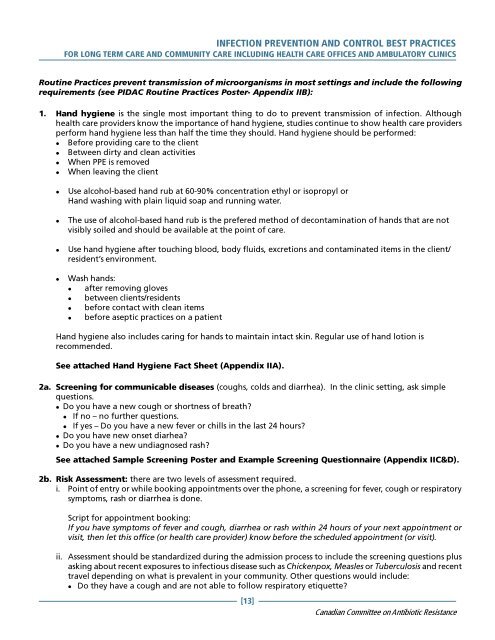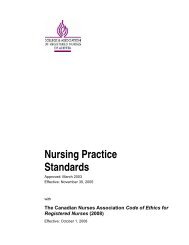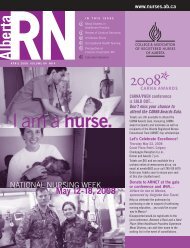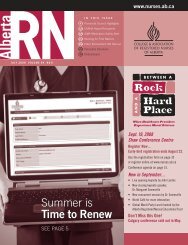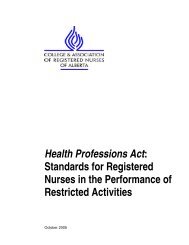Infection Prevention and Control Best Practices - College ...
Infection Prevention and Control Best Practices - College ...
Infection Prevention and Control Best Practices - College ...
Create successful ePaper yourself
Turn your PDF publications into a flip-book with our unique Google optimized e-Paper software.
INFECTION PREVENTION AND CONTROL BEST PRACTICES<br />
FOR LONG TERM CARE AND COMMUNITY CARE INCLUDING HEALTH CARE OFFICES AND AMBULATORY CLINICS<br />
Routine <strong>Practices</strong> prevent transmission of microorganisms in most settings <strong>and</strong> include the following<br />
requirements (see PIDAC Routine <strong>Practices</strong> Poster- Appendix IIB):<br />
1. H<strong>and</strong> hygiene is the single most important thing to do to prevent transmission of infection. Although<br />
health care providers know the importance of h<strong>and</strong> hygiene, studies continue to show health care providers<br />
perform h<strong>and</strong> hygiene less than half the time they should. H<strong>and</strong> hygiene should be performed:<br />
� Before providing care to the client<br />
� Between dirty <strong>and</strong> clean activities<br />
� When PPE is removed<br />
� When leaving the client<br />
� Use alcohol-based h<strong>and</strong> rub at 60-90% concentration ethyl or isopropyl or<br />
H<strong>and</strong> washing with plain liquid soap <strong>and</strong> running water.<br />
� The use of alcohol-based h<strong>and</strong> rub is the prefered method of decontamination of h<strong>and</strong>s that are not<br />
visibly soiled <strong>and</strong> should be available at the point of care.<br />
� Use h<strong>and</strong> hygiene after touching blood, body fluids, excretions <strong>and</strong> contaminated items in the client/<br />
resident’s environment.<br />
� Wash h<strong>and</strong>s:<br />
� after removing gloves<br />
� between clients/residents<br />
� before contact with clean items<br />
� before aseptic practices on a patient<br />
H<strong>and</strong> hygiene also includes caring for h<strong>and</strong>s to maintain intact skin. Regular use of h<strong>and</strong> lotion is<br />
recommended.<br />
See attached H<strong>and</strong> Hygiene Fact Sheet (Appendix IIA).<br />
2a. Screening for communicable diseases (coughs, colds <strong>and</strong> diarrhea). In the clinic setting, ask simple<br />
questions.<br />
� Do you have a new cough or shortness of breath?<br />
� If no – no further questions.<br />
� If yes – Do you have a new fever or chills in the last 24 hours?<br />
� Do you have new onset diarhea?<br />
� Do you have a new undiagnosed rash?<br />
See attached Sample Screening Poster <strong>and</strong> Example Screening Questionnaire (Appendix IIC&D).<br />
2b. Risk Assessment: there are two levels of assessment required.<br />
i. Point of entry or while booking appointments over the phone, a screening for fever, cough or respiratory<br />
symptoms, rash or diarrhea is done.<br />
Script for appointment booking:<br />
If you have symptoms of fever <strong>and</strong> cough, diarrhea or rash within 24 hours of your next appointment or<br />
visit, then let this office (or health care provider) know before the scheduled appointment (or visit).<br />
ii. Assessment should be st<strong>and</strong>ardized during the admission process to include the screening questions plus<br />
asking about recent exposures to infectious disease such as Chickenpox, Measles or Tuberculosis <strong>and</strong> recent<br />
travel depending on what is prevalent in your community. Other questions would include:<br />
� Do they have a cough <strong>and</strong> are not able to follow respiratory etiquette?<br />
[13]<br />
Canadian Committee on Antibiotic Resistance


